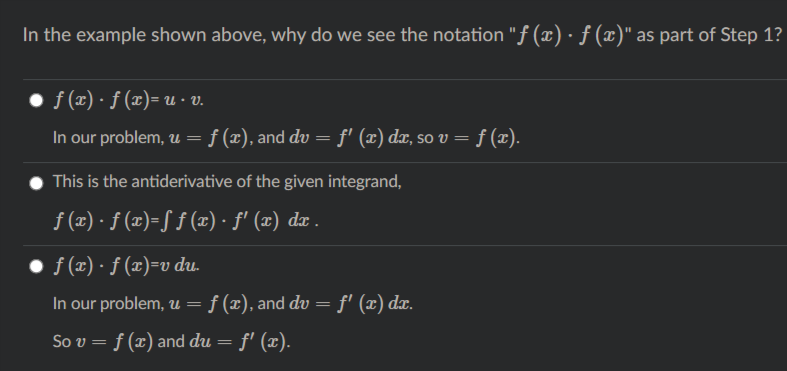In the example shown above, why do we see the notation "f (x) · f (x)" as part of Step 1? f (x) · f (x)= u · v. In our problem, u = f (x), and dv = f' (x) dx, so v = f (x). This is the antiderivative of the given integrand, f (x) · f (x)=S ƒ (x) · f' (æ) dæ . • f (x) · f (x)=v du. In our problem, u = f (x), and dv = f' (x) dx.
In the example shown above, why do we see the notation "f (x) · f (x)" as part of Step 1? f (x) · f (x)= u · v. In our problem, u = f (x), and dv = f' (x) dx, so v = f (x). This is the antiderivative of the given integrand, f (x) · f (x)=S ƒ (x) · f' (æ) dæ . • f (x) · f (x)=v du. In our problem, u = f (x), and dv = f' (x) dx.
Functions and Change: A Modeling Approach to College Algebra (MindTap Course List)
6th Edition
ISBN:9781337111348
Author:Bruce Crauder, Benny Evans, Alan Noell
Publisher:Bruce Crauder, Benny Evans, Alan Noell
ChapterA: Appendix
SectionA.2: Geometric Constructions
Problem 10P: A soda can has a volume of 25 cubic inches. Let x denote its radius and h its height, both in...
Related questions
Question
100%
![Let f and f' be continuous functions on [a, b].
Use integration by parts to show that f. f (x) f' (¤) dæ = } (f(b)² – f(a)²).
In the steps that follow, we will use u =
f (x), dv= f' (x) dæ.
The next question asks about these steps.
Step 1: Apply u dv =
uv, – L v du
Step 1: S. f (x) f' (x) dx
= f (x) · f (x) . – S. f (2) f' (2) dæ
Step 2: Gather like terms.
Step 2: 2 S. f (x) f' (2) dr = f (x) · f (x) 2
Step 3: Plug in the limits of integration, and subtract.
Step 3: 2 f f (x) f' (z) da = f(b)² – f(a)²
Step 4: Divide both sides of the equation by 2.
Step 4: S. f (2) f' (2) dz =}(5(b)² – f(a)°)
(50)² – f(@})](/v2/_next/image?url=https%3A%2F%2Fcontent.bartleby.com%2Fqna-images%2Fquestion%2F960ae8a4-c7ad-42cb-a670-12c7a1239527%2F316bebd6-d49a-4f09-a679-14a6cade22f9%2Fu15096y_processed.png&w=3840&q=75)
Transcribed Image Text:Let f and f' be continuous functions on [a, b].
Use integration by parts to show that f. f (x) f' (¤) dæ = } (f(b)² – f(a)²).
In the steps that follow, we will use u =
f (x), dv= f' (x) dæ.
The next question asks about these steps.
Step 1: Apply u dv =
uv, – L v du
Step 1: S. f (x) f' (x) dx
= f (x) · f (x) . – S. f (2) f' (2) dæ
Step 2: Gather like terms.
Step 2: 2 S. f (x) f' (2) dr = f (x) · f (x) 2
Step 3: Plug in the limits of integration, and subtract.
Step 3: 2 f f (x) f' (z) da = f(b)² – f(a)²
Step 4: Divide both sides of the equation by 2.
Step 4: S. f (2) f' (2) dz =}(5(b)² – f(a)°)
(50)² – f(@})

Transcribed Image Text:In the example shown above, why do we see the notation "f (x) · ƒ (x)" as part of Step 1?
f (x) · f (x)= u · v.
In our problem, u = f (x), and dv = f' (x) dx, so v = f (x).
This is the antiderivative of the given integrand,
f (x) · f (x)=S ƒ (x) · f' (x) dx .
f (x) · ƒ (x)=v du.
In our problem, u = f (x), and dv = f' (x) dx.
So v = f (x) and du = f' (x).
Expert Solution
This question has been solved!
Explore an expertly crafted, step-by-step solution for a thorough understanding of key concepts.
This is a popular solution!
Trending now
This is a popular solution!
Step by step
Solved in 2 steps with 1 images

Recommended textbooks for you

Functions and Change: A Modeling Approach to Coll…
Algebra
ISBN:
9781337111348
Author:
Bruce Crauder, Benny Evans, Alan Noell
Publisher:
Cengage Learning

Functions and Change: A Modeling Approach to Coll…
Algebra
ISBN:
9781337111348
Author:
Bruce Crauder, Benny Evans, Alan Noell
Publisher:
Cengage Learning